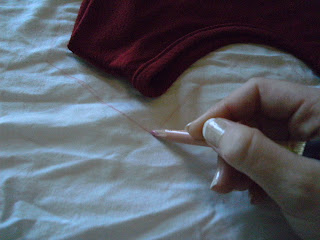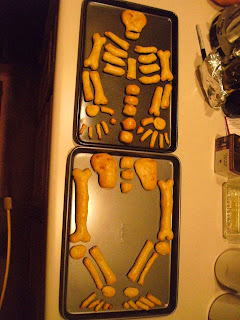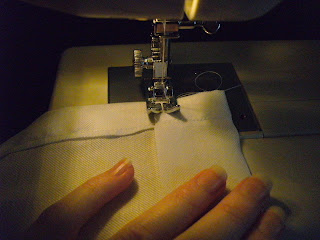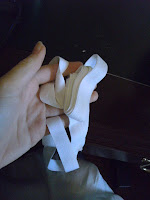It looks like I will have to leave the sexy to the other women in the world this year. I am too round to be classified as "sexy" I think.
I hate buying commercial costumes because they are so cheaply made and cost so much, but it doesn't matter this year anyway. There is no such thing as a maternity costume. Apparently my only option while preggers is to buy a plus sized costume. Well, my belly may be round, but the rest of me is far from plus size and I doubt that is a viable option for me. I did scope Target.com for some ideas about what to be, and I found a cute little number that will be empire waisted enough to flow over the curves. A greek/roman goddess. Yay for feminine and pretty and still a little sexy!
Since a pattern wont fit me without major modifications, I decided to wing it. Its a simple enough silhouette, so I should be able to make it work, right? Feel free to make it short and save on fabric.
Self-Faced Greek/Roman Goddess Dress Costume
You will need:
about 4-5 yards of white cotton fabric, either 45 or 60 inches wide is fine
a belt, pretty sash, chain, or ribbon to cinch the waist
a top (or dress) with a cowl neckline that fits you well
dressmaker's pencil, chalk, or fabric pen with disappearing ink for tracing lines
a good pair of shears - you will be cutting through 4 layers of fabric
sewing machine and thread
serger (optional)
Step 1: Lay out your fabric. To make your outfit the most symmetrical possible, fold it in half long ways (if you bought it on a standard bolt, you can use the center fold line from that). Place your top on the fabric. The midline of the top should match up with the center fold of the fabric. Leave some extra fabric sticking out above the top for the self facing. For how much extra to leave, see step 5.
 |
| Mine is not centered over the fabric because this is a non maternity top and I needed it to go round the belly! |
Step 3: Measure how much skirt length you will need. Measure from where the shirt ends on you to where you want the skirt to end and add just a little bit for a hem. I made mine floor length and needed to add 35". Mark the length and use a straight edge to draw a line across the whole width of the fabric.
Step 4: Now you get to freehand the silhouette of the skirt. Connect the line from tracing the top to the hemline. Depending on how full you want the skirt and how wide your fabric is, you may want to run it all the way out to the selvage edge, but you may want to make it a little more tapered, depending on your preference. I ran mine out all the way to the selvage edge. I also didn't follow the line of the top very well since it doesn't actually fit me, but you get the idea.
Step 5: Now that you have your outline drawn, you are ready to cut! To create the self facing top, you will need to fold under the top edge of the fabric at the neckline so you are cutting an extra layer. This actually means that you are cutting through 4 layers of fabric since it is already folded in half. Make sure there is enough overlap to reach just below the armhole edges.
Cut along your traced lines.
When you open out the facing, it will look like this:
Step 6: Use your cutout as a template for the back of the dress. I made mine a lot narrower since I am pregnant and it saves on fabric not to have so much extra width, but you can just reuse the same shape. Cut an exact replica on the fold again so you have 2 of the same piece.
Step 7: Now we get to the sewing part! Unfold the two pieces. Finish the top edge of the facing for both. Either run it through a serger or create a narrow hem so the edge does not fray. It doesn't have to be beautiful as it will be turned to the inside, but you don't want the facing falling apart.
Step 8: With right sides together, fold the facing toward the dress along the neck edge. Pin the facing and the dress together along the armhole edges. Stitch the armhole edges together at the 5/8" seam allowance. Stitch again, close to the stitching inside the seam allowance and trim the seam. Repeat for both sides and for front and back. Turn the facing right side out.
 |
| I pinned the extra down the side, but do not stitch there. Only stitch the curved armhole edge! |
 |
| double stitch to reinforce and then trim so you can turn the facing in. If it still wont turn, clip the curve. |
Step 9: Along the shoulder seams there will now be a kind of "pocket". To stitch the shoulder seams, you will have to fold the seam allowance of the back piece into the pocket and slip the seam allowance of the front piece into the opening. Make sure the shoulder widths of the two pieces are even by sliding the pieces together or apart as needed, then top stitch them together. Repeat for both sides.
 |
| Edges are not yet even, slide them around until they match up! |
Step 11: Try on dress. If needed, trim the hem a little so it falls where you want it to fall, and to make it even. The hem may not be perfectly straight since we did not curve the lower edge, but it should be close enough. If it really bugs you, feel free to tinker! :-) Hem the lower edge and you are done!
Step 12: Put dress on and use the belt or ribbon or whatever to tie around your waist or just under the bust for an empire waist. Adjust the fullness of the neckline to suit you and admire your hard work!
Bottom Line:
5 yards fabric at $2/yd = $10 (Use muslin or bargain bin fabric for this! I used some stash fabric I have had since 2005. No cost to me! YAY!)
Total cost: $10
Total time: about 3 hours, including figuring out how to cut and assemble. Should be less for you!
My neckline was a little too loose when I bent over, but I don't think hubby minded looking down my dress all day. My armholes were a little snug, too, so I went back and made them a little larger. If you don't have a cowl neck top to copy, just make a straight line across the top and try using the armhole outline from another sleeveless top. Copy the general shape of my layout and you should be okay. This isn't high fashion quality sewing... its meant to be an alternative to a bedsheet with eyes cut out!
A few general notes: the self facing may seem like a pain to cut and sew, but it will prevent you from having to bind all your edges, which I absolutely hate doing, as well as allow for a second layer of fabric along the bust which adds to modesty. You choose which you prefer and roll with it. If you are tracing a stretchy top, beware! If it has to stretch to fit you, leave some extra in there otherwise the non stretchy cotton will not fit! Also, whcn choosing fabric, don't pick something so cheap that it is see thru! Good Luck!
Happy Halloween!





























































